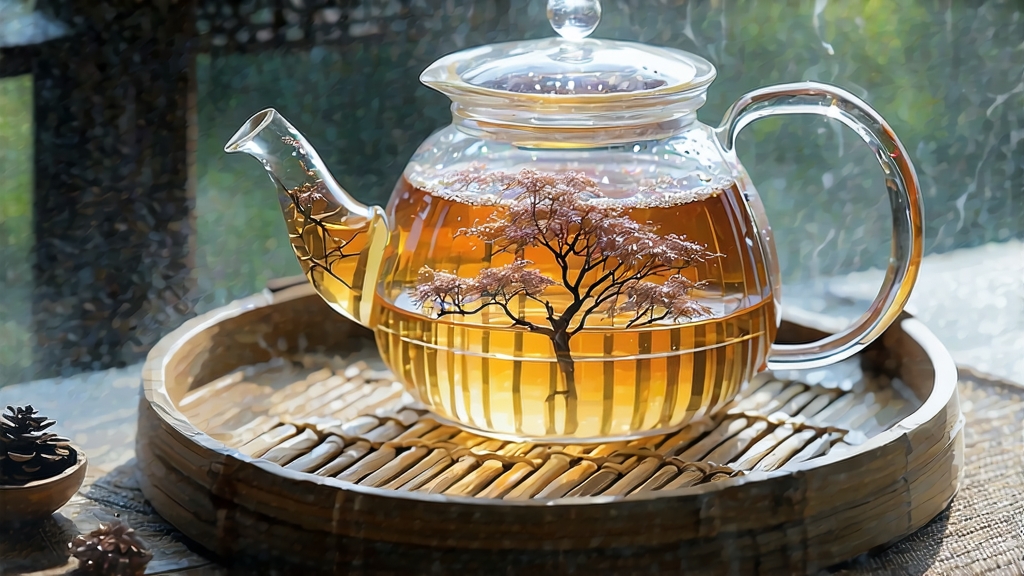
Tucked away in the northeastern corner of Fujian province, where the Wuyi Mountains exhale cool mist over granite soils and subtropical breezes carry the scent of wild orchids, a tea so delicate that it must be plucked before the village rooster finishes his first call waits for sunrise. Locals call it Bai Hao Yin Zhen—White Hair Silver Needle—and for more than two centuries it has been the luminous apex of China’s white-tea family, a category defined by minimal intervention and maximal poetry. Unlike green tea that is pan-fired or oolong that is coaxed into partial oxidation, Silver Needle is allowed to simply “sleep” in the mountain air, letting time and dew finish what fire refuses to touch. The result is a liquor the color of first light, a fragrance that drifts between fresh melon and standing timber, and a sweetness that arrives long after the cup is empty, like an echo you cannot quite name.
Historical whispers place the birth of Silver Needle during the Jiaqing era of the Qing dynasty, when a Fujian prefect offered “needle-shaped tribute tea” to the imperial court. The emperor’s tasters, accustomed to the smoky swagger of Wuyi rock oolong, were startled by a tea that spoke in hushed tones. By the late nineteenth century, foreign merchants in Fuzhou’s treaty port were exporting the downy buds to Europe, where Victorian ladies believed the pale infusion preserved porcelain complexions. During the 1970s, when white tea was still largely unknown beyond China, state-run factories compressed Silver Needle into commemorative cakes labeled “export special”; those bricks now fetch astronomical prices at Kuala Lumpur auctions, their inner tags browned but the aroma miraculously intact, like a letter never opened.
Botanically, only two cultivars are granted the privilege of becoming authentic Silver Needle: Fuding Da Bai and Zhenghe Da Bai, both “big white” tea trees selected for their oversized buds sheathed in gossamer hairs. The Fuding strain yields a slimmer, more erect needle and a brighter cup, while Zhenghe produces plumper buds and a deeper, hay-like sweetness. Purists insist that any plucking before the Qingming festival—usually April 4th—captures the quintessential spring qi, yet climate change has nudged the optimal window earlier by nearly a week. A single kilogram of finished Silver Needle demands between thirty and forty thousand buds, all picked at dawn when dew still beads like quicksilver, all sorted by hand on bamboo trays within two hours to prevent compression bruises.
The craft protocol sounds deceptively simple: pick, wither, dry. Yet each verb hides a cosmos. Fresh buds are spread one layer deep on water-reed mats set inside sun-warmed corridors whose walls breathe decades of tea vapor. For the first six hours, master witherers refuse to touch the leaf; they only watch the sun arc across lattice windows, adjusting slats to keep temperature between 26 and 28 °C. When the bud’s moisture drops to roughly forty percent, it enters the “soft wither” phase—gentle shuffling every twenty minutes to coax even dehydration. Finally, the semi-dry needles are transferred to a charcoal-heated chamber whose walls are lined with paulownia ash, maintaining a bashful 35 °C for another four hours. No machine can replicate the intuitive decision of when to finish; the tea maker pinches a bud between forefinger and thumb, listening for the almost inaudible snap that signals the soul has settled.
Because Silver Needle is the least processed of all Camellia sinensis offerings, it is also the most transparent, betraying every mistake of terroir, plucking or storage. A bud harvested in rain will taste of wet cardboard; over-withering bakes away the jasmine nuance; inadequate drying invites a musty ghost that no amount of aging will exorcise. Conversely, when conditions align, the tea becomes a time capsule. Under controlled humidity of 55–65 % and steady temperatures around 25 °C, Silver Needle can evolve for decades, trading fresh cucumber notes for dark honey, polished wood and the elusive Chinese medicine scent of “chen xiang” (aged aloeswood). A 1997 Fuding cake recently uncorked in Hong Kong offered the sensory equivalent of entering an abandoned cedar temple where incense still clings to rafters.
Western drinkers often brew Silver Needle like a green tea—boiling water, three minutes, mug prison